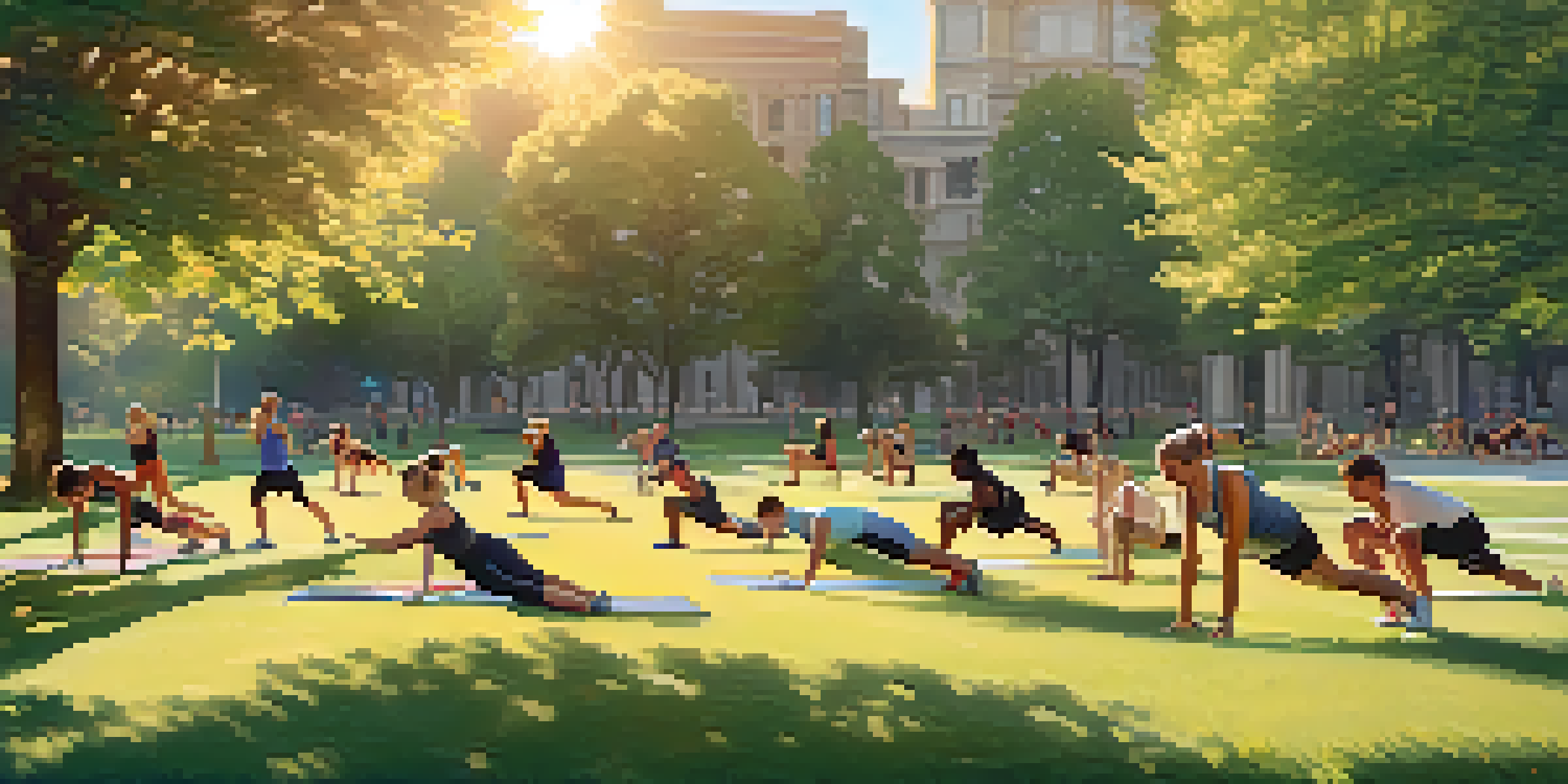Creating a Full-Body Workout Routine Without Equipment

Understanding the Benefits of Bodyweight Workouts
Bodyweight workouts are fantastic for building strength, flexibility, and endurance without the need for any equipment. They utilize your own weight as resistance, which can be highly effective for all fitness levels. Plus, they can be done anywhere, making it easy to fit exercise into your busy schedule.
Fitness is not about being better than someone else. It’s about being better than you used to be.
One of the key advantages of bodyweight exercises is their ability to enhance functional fitness. This means you're training your muscles to work together more efficiently, which translates into better performance in daily activities. Think about lifting groceries or climbing stairs—these movements become easier when you train your body with exercises that mimic them.
Additionally, bodyweight workouts can significantly improve your cardiovascular health. By incorporating high-intensity interval training (HIIT) moves, you can elevate your heart rate and burn calories effectively. It’s a win-win situation: you get fit while feeling energized!
Setting Clear Fitness Goals for Your Routine
Before you dive into your workout routine, it's essential to set clear and achievable fitness goals. Whether you want to build strength, improve endurance, or lose weight, having specific goals can guide your workout choices and keep you motivated. For example, you might aim to perform a certain number of push-ups or hold a plank for a specific duration.

When setting goals, consider using the SMART criteria—Specific, Measurable, Achievable, Relevant, and Time-bound. This method can help you create a roadmap for your fitness journey. For instance, instead of saying 'I want to get fit,' you could say, 'I want to do 20 squats every day for the next month.'
Bodyweight Workouts for All Levels
These workouts utilize your own weight as resistance, making them effective and accessible for anyone, anywhere.
Remember, it's crucial to celebrate your progress, no matter how small. Achieving milestones can boost your confidence and keep you engaged in your fitness routine. So, whether it’s a week of consistency or hitting a new personal best, take a moment to acknowledge your hard work!
Designing Your Full-Body Workout Routine
Creating a full-body workout routine involves selecting a variety of exercises that target different muscle groups. A balanced routine should include push, pull, and leg movements to ensure all areas are engaged. For instance, you can combine push-ups for your chest, pull-ups (or inverted rows) for your back, and squats for your legs.
The body achieves what the mind believes.
Consider structuring your workout into circuits or supersets. This means performing one exercise after another without resting in between, which can help keep your heart rate up and maximize efficiency. For example, you might do 10 push-ups followed by 10 squats, then repeat the circuit three times.
Always remember to include a warm-up and cool-down in your routine. A simple warm-up could involve dynamic stretches or light jogging in place, while a cool-down could consist of static stretches to help improve flexibility and reduce muscle soreness. These components are vital for preventing injuries and promoting recovery.
Incorporating Warm-Up and Cool-Down Exercises
Warming up before any workout is crucial as it prepares your body for the physical activity ahead. A proper warm-up gradually increases your heart rate and blood flow to the muscles, reducing the risk of injury. You can start with five to ten minutes of light cardio, such as jogging or jumping jacks.
In addition to cardio, dynamic stretches are an excellent way to warm up your muscles. Consider movements like arm circles, leg swings, or walking lunges to encourage mobility and flexibility. These activities help to activate the muscles you'll be using in your workout, ensuring you're ready to go.
Set SMART Fitness Goals
Establishing specific, measurable, achievable, relevant, and time-bound goals can guide your fitness journey and keep you motivated.
After your workout, cooling down is just as important. This phase allows your body to gradually transition back to a resting state and aids in recovery. Incorporate static stretches like hamstring stretches or shoulder stretches to help improve flexibility and alleviate muscle tension. Taking this time for yourself can enhance your overall fitness experience.
Essential Bodyweight Exercises for a Full-Body Routine
Some go-to bodyweight exercises that effectively target multiple muscle groups include push-ups, squats, lunges, and planks. Push-ups work your chest, shoulders, and triceps, while squats primarily engage your legs and glutes. Incorporating these exercises into your routine can provide a solid foundation for building strength.
Don’t forget about core exercises, which are crucial for stability and overall body strength. Planks, mountain climbers, and bicycle crunches are excellent for engaging your core muscles. A strong core not only improves your posture but also enhances your performance in other exercises.
You can also add variations to these exercises to keep your routine fresh and challenging. For example, try incline push-ups, jump squats, or side planks to target your muscles from different angles. This variation helps prevent plateaus and keeps your workouts exciting!
Creating a Balanced Weekly Workout Schedule
To make the most of your bodyweight workout routine, it's important to create a balanced weekly schedule. Aim for at least three to five workout sessions per week, interspersed with rest days for recovery. This approach allows your muscles to repair while still maintaining consistency in your training.
Consider alternating between different types of workouts to target various muscle groups and prevent boredom. For instance, you could focus on upper body exercises one day, lower body the next, and core workouts on another day. This variety not only keeps things interesting but also promotes balanced muscle development.
Balance Your Weekly Workout Schedule
Creating a diverse workout schedule with adequate rest and varying exercises promotes overall fitness and prevents boredom.
Additionally, listen to your body and adjust your schedule as needed. If you feel particularly sore or fatigued, it's okay to take an extra rest day or opt for a lighter workout. The key is to stay flexible and prioritize your overall well-being while striving for your fitness goals.
Tracking Your Progress and Staying Motivated
Tracking your progress is a fantastic way to stay motivated and see how far you've come. Consider keeping a workout journal where you can log your exercises, sets, and reps. This not only helps you stay accountable but also allows you to identify patterns and areas for improvement.
Another effective method is to take progress photos or measurements. Sometimes, changes in your body aren't as noticeable day-to-day, but over weeks or months, they can be significant. Seeing visual proof of your hard work can be incredibly encouraging and help you stay committed to your routine.

Lastly, consider involving a workout buddy or joining an online community for added motivation. Sharing your journey with others can provide support, accountability, and even a little bit of friendly competition. Together, you can celebrate each other's successes and enjoy the process of getting fit!